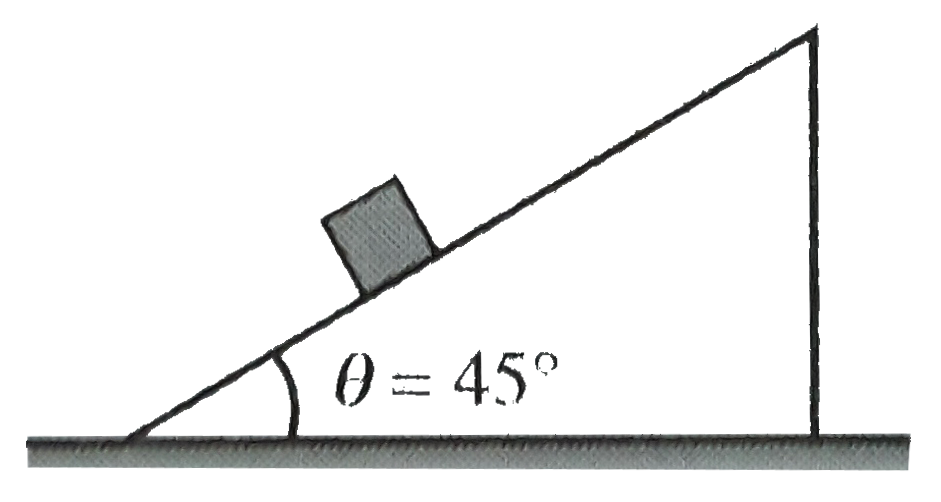The body of mass 400 g slides on a rough horizontal surface. If the frictional force is 3.0 N, find a. the angle made by the contact force on the body with the vertical and b. the magnitude of the contact force. Take g=10ms2
To solve the problem, we need to find two things:
1. The angle made by the contact force with the vertical.
2. The magnitude of the contact force.
Let's go through the solution step by step.
Step 1: Calculate the weight of the body
The weight of the body (W) can be calculated using the formula:
W=m⋅g
where:
- m=400g=0.4kg (convert grams to kilograms)
- g=10m/s2 (acceleration due to gravity)
Calculating the weight:
W=0.4kg⋅10m/s2=4N
Step 2: Identify the forces acting on the body
On the rough horizontal surface, two main forces act on the body:
- The normal force (N) acting vertically upwards.
- The frictional force (F_f) acting horizontally opposite to the direction of motion.
Given:
- Frictional force Ff=3N
Since the body is not moving vertically, the normal force must balance the weight of the body:
N=W=4N
Step 3: Calculate the angle made by the contact force with the vertical
The contact force (F_c) is the resultant of the normal force and the frictional force. We can use trigonometry to find the angle θ made by the contact force with the vertical.
Using the tangent function:
tan(θ)=Frictional ForceNormal Force
tan(θ)=FfN=3N4N
Now, calculating θ:
θ=tan−1(34)
Using a calculator or trigonometric tables, we find:
θ≈37∘
Step 4: Calculate the magnitude of the contact force
The magnitude of the contact force (F_c) can be calculated using the Pythagorean theorem since the frictional force and the normal force are perpendicular to each other:
Fc=√F2f+N2
Substituting the values:
Fc=√(3N)2+(4N)2
Fc=√9+16
Fc=√25
Fc=5N
Final Answers
a. The angle made by the contact force with the vertical is approximately 37∘.
b. The magnitude of the contact force is 5N.
1. The angle made by the contact force with the vertical.
2. The magnitude of the contact force.
The weight of the body (W) can be calculated using the formula:
W=m⋅g
where:
- m=400g=0.4kg (convert grams to kilograms)
- g=10m/s2 (acceleration due to gravity)
W=0.4kg⋅10m/s2=4N
On the rough horizontal surface, two main forces act on the body:
- The normal force (N) acting vertically upwards.
- The frictional force (F_f) acting horizontally opposite to the direction of motion.
- Frictional force Ff=3N
N=W=4N
The contact force (F_c) is the resultant of the normal force and the frictional force. We can use trigonometry to find the angle θ made by the contact force with the vertical.
tan(θ)=Frictional ForceNormal Force
tan(θ)=FfN=3N4N
θ=tan−1(34)
θ≈37∘
The magnitude of the contact force (F_c) can be calculated using the Pythagorean theorem since the frictional force and the normal force are perpendicular to each other:
Fc=√F2f+N2
Fc=√(3N)2+(4N)2
Fc=√9+16
Fc=√25
Fc=5N
a. The angle made by the contact force with the vertical is approximately 37∘.
b. The magnitude of the contact force is 5N.
Topper's Solved these Questions
- FRICTIONBOOK - HC VERMA ENGLISHCHAPTER - FRICTIONEXERCISE - worked out Examples
10 Videos
- FRICTIONBOOK - HC VERMA ENGLISHCHAPTER - FRICTIONEXERCISE - Objective -1
10 Videos
- FLUID MECHANICSBOOK - HC VERMA ENGLISHCHAPTER - FLUID MECHANICSEXERCISE - All Questions
90 Videos
- GRAVITATIONBOOK - HC VERMA ENGLISHCHAPTER - GRAVITATIONEXERCISE - Question for short Answers
18 Videos
Similar Questions
A block is sliding on a rough horizontal surface. If the contact force on the block is √2 times the frictional force, the coefficient of friction is
View SolutionA body of mass 2kg is kept on a rough horizontal surface as shown in the figure. If coefficient of friction is 0.5, find the work done by frictional force in the interval t=0 to t=5sec

View SolutionA body of mass m is kept on a rough horizontal surface of friction coefficient μ . A force P is applied horizontally , but the body is not moving .Find the net force F exerted by the surface on the body .
View SolutionA block is in limiting equilibrium on a rough horizontal surface. If the net contact force is √3 times the normal force, the coefficient of static friction is
View SolutionA block of mass 2 kg rests on a horizontal surface. If a horizontal force of 5 N is applied on the block, the frictional force on it is (take,uk=0.4,μs=0.5)
View SolutionA block of mass m=3kg slides on a rough inclined plane of cofficient of friction 0.2 Find the resultant force offered by the plane on the block

View SolutionA block of mass 5kg is lying on a rough horizontal surface. The coefficient of static and kinetic friction are 0.3 and 0.1 and g=10ms−2 The frictional force on the block is
View SolutionA weight W rests on a rough horizontal plane,If the angle of friction is θ,the least force that can move the body along the plane will be
View SolutionA block of mass 10kg is placed on a rough horizontal surface having coefficient of friction μ=0.5 . If a horizontal force of 100N is acting on it, then acceleration of the will be.
View SolutionA block of mass 10kg is placed on a rough horizontal surface having coefficient of friction μ=0.5 . If a horizontal force of 100N is acting on it, then acceleration of the will be.
View Solution
